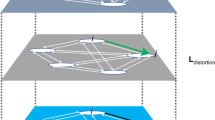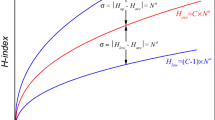Abstract
In this paper we extend our studies to the micro-structure of the Matthew effect for countries (MEC). The MEC allows the ranking of countries by their Matthew Index. The rank distribution of countries, observable only at a macro-level, has its roots in re-distribution processes of citations in every journal of the database. These re-distributed citations we call Matthew citations. Data for 44 countries and 2712 journals (based on theScience Citation Index) are analyzed. The strength of the contribution of the individual journals to the MEC (their number of Matthew citations) is skewly distributed. Due to this high concentration of the MEC we are able to define a new type of journal the Matthew core journal: 145 Matthew core journals account for 50% of the MEC. These journals carry a high potential of gaining a surplus of citations over what is expected and the risk of losing a high number of citations as well.
Similar content being viewed by others
References
J. D. Frame, F. Narin, M. P. Carpenter, The distribution of world science,Social Studies of Science, 7 (1977) 501–516.
H. Eto, Science Revolution and the Ortega hypothesis in developing countries,Scientometrics, 20 (1991) 283–295.
M. Bonitz, E. Bruckner, A. Scharnhorst, The Science Strategy Index,Scientometrics, 26 (1993) 37–50.
J. F. Miquel, Y. Okubo, Structure of international collaboration in science—Part II: Comparison of profiles in countries using a link indicator,Scientometrics 29 (1994) 271–297.
Second European Report on S&T Indicators 1997, Vol. 1–2 Luxembourg 1997.
National Science Board, Science & Engineering Indicators—1998, Arlington, VA: National Science Foundation, 1998.
A. Schubert, T. Braun, Relative indicators and relational charts for comparative assessment of publication output and citation impact,Scientometrics, 9 (1986) 283.
A. Schubert, W. Glänzel T. Braun, Scientometric Datafiles. A Comprehensive set of indicators on 2649 journals and 96 countries in all major science fields and subfields 1981–1985,Scientometrics, 16 (1989) 3–478.
T. Braun, A. Schubert, The landscape of national performance in the sciences, 1981–1985,Scientometrics 20 (1991) 9–17.
S. Bauin, H. Rothman, Impact of journals as proxies for citation counts. In:Representations of Science and Technology,P. Weingart R. Sehringer, M. Winterhager, (Eds.) Leiden DSWO Press 1992, pp. 225–235.
P. O. Seglen, The skewness of science,JASIS 43 (1992) 628–638.
R. K. Merton, The Matthew effect in science,Science, 159 (1968) 56–62.
M. Bonitz, E. Bruckner, A. Scharnhorst, Characteristics and impact of the Matthew effect for countries,Scientometrics, 40 (1997) 407–422.
M. Bonitz, E. Bruckner, A. Scharnhorst, The structure of world science in the eighties: Country maps 1985–1989 versus 1980–1984. In:Proceedings of the Fifth International Conference of the International Society for, Scientometrics and Informetrics, June 7–10, 1995, River Forest, Il., U.S.A.M.E.D. Koenig, A. Bookstein, (Eds.) Learned Information, Medford, NJ., U.S.A. 1995, pp. 63–72.
M. Bonitz, The scientific talents of nations,Libri, 47 (1997) 206–213.
J.S. Katz, Power laws, similarity and diversity in national systems of innovation.Fifth International Conference on Science and Technology Indicators, Hinxton, Cambridge, England, June 4–6, 1998, see URL http://sahara.fsw.leidenuniv.nl/s&tconference/abstracts.html
E. Garfield, The significant scientific literature appears in a small core of journals,The Scientist, 10 (1996) No. 17, September, 2, pp. 13, 16.
Author information
Authors and Affiliations
Rights and permissions
About this article
Cite this article
Bonitz, M., Bruckner, E. & Scharnhorst, A. The matthew index—Concentration patterns and Matthew core journals. Scientometrics 44, 361–378 (1999). https://doi.org/10.1007/BF02458485
Received:
Issue Date:
DOI: https://doi.org/10.1007/BF02458485




